

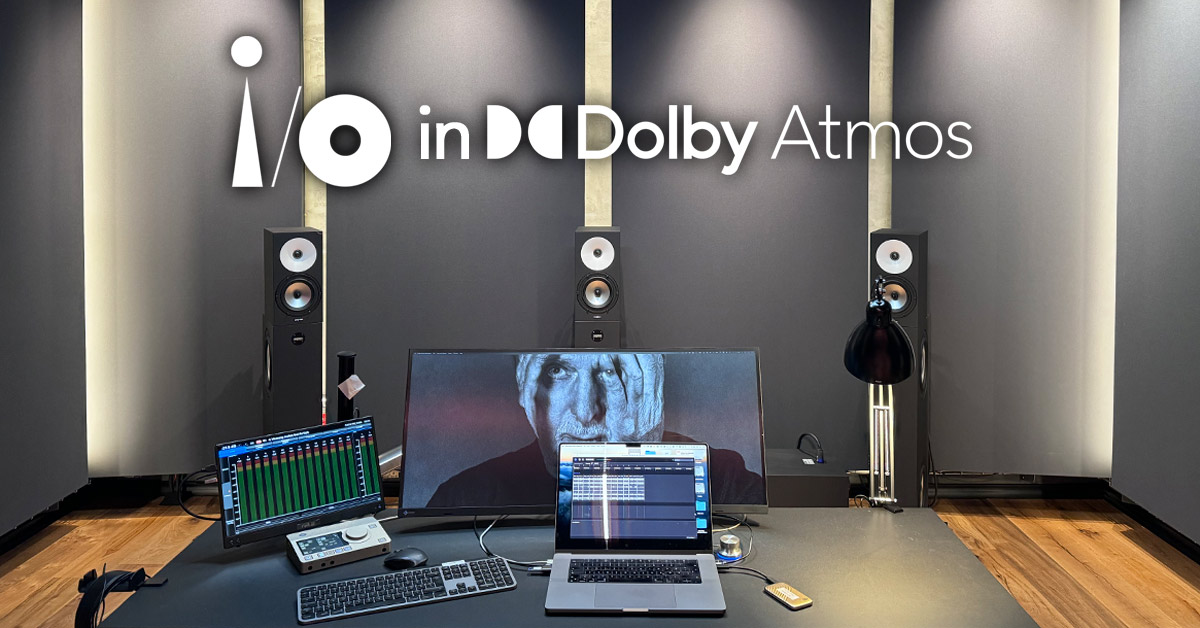
It's Tuesday, 2 January 2024. A rainy, uncomfortable day in Berlin, but a delegation of GNC editors and competition winners have travelled here from various regions in Germany for a special event. At three in the afternoon, the five of us head for the msm-Studios, which we find in the so-called Bergmannkiez neighbourhood in the backyard of a turn-of-the-century apartment building. The glazed door is opened for us by a friendly middle-aged man with a bald head, greying beard and round glasses. He greets us with a handshake.
The person asking us to join him is Hans-Martin Buff, sometimes just called Buff in the UK, the man who created the Dolby Atmos mixes for Peter Gabriel's i/o. And he wants to present this work to us, so he called us and asked if we would be interested. Of course we were and took the chance to meet him.
 Hans-Martin is a very friendly, engaging person who talks to us without any reservation, but at the same time shows so much relaxed sovereignty that you don't doubt for a second that he can hold his own against greats like Prince or the Scorpions.
Hans-Martin is a very friendly, engaging person who talks to us without any reservation, but at the same time shows so much relaxed sovereignty that you don't doubt for a second that he can hold his own against greats like Prince or the Scorpions.
The studio space is kept simple, but in a way that makes it a pleasure to spend time there. We also briefly meet Stefan Bock, co-owner and developer of the "Pure Audio" Blu-ray, which can be operated like a CD without a screen and allow you to switch back and forth between Atmos and other mixes. For example on the i/o Blu-ray ...
While still standing, Hans-Martin then gives us a brief introduction to what Dolby Atmos actually means: compared to surround in 5.1, there are more speakers all around - which enables more detailed sound distribution - and more speakers under the ceiling, which also brings the "top" level into play. Every modern Dolby Atmos playback system can also recognise the exact setup in the room and adapt the sound output accordingly. An Atmos mix can therefore be heard through a wide variety of speaker configurations - right down to stereo headphones, for which spatial sound distribution is achieved through "psychoacoustic" tricks.
The technology was actually developed for film, but it is also ideal for playing music. As this method is still relatively new, the msm-Studios in Berlin have set up a room (there has been one in Munich already) that enables the presentation of Atmos music in order to publicise its possibilities in the capital.
 To this room we're going now. It is suitable for presentations to small groups (Hans-Martin had allowed us a maximum of eight participants in advance). Approximately 5 x 8 metres, light wooden floor, acoustic panels in dark grey on the walls, part of the ceiling in red. The furnishings are efficient yet stylish.
To this room we're going now. It is suitable for presentations to small groups (Hans-Martin had allowed us a maximum of eight participants in advance). Approximately 5 x 8 metres, light wooden floor, acoustic panels in dark grey on the walls, part of the ceiling in red. The furnishings are efficient yet stylish.
The technical speaker distribution here is 9.1.4 - which means nine speakers all round, a subwoofer and four speakers under the ceiling. Hans-Martin has brought his work notebook, connected it to the studio equipment and will play us the music directly from his project files.
Hans-Martin has known Peter Gabriel since 2020, when he started creating special headphone mixes at Real World. As Dolby Atmos is a hot topic in the music scene at the moment, and streaming platforms in particular are keen on it, a respective mix for i/o was considered - around June 2022. Hans-Martin, who is experienced in this field, offered his services, but first had to deliver something like a test work and was given a hard drive with all the recorded tracks in return.
He chose Four Kinds Of Horses, apparently met Gabriel's taste with his first attempt and got the job. After Hans-Martin tells us this, he makes an enthusiastic victory gesture with both arms, closing his eyes. He seems very happy to have been able to work on the album. He's also a Gabriel fan - especially appreciates US.
The individual i/o tracks were then mixed throughout the year 2023. Always in blocks of three or four - according to the announcements of what was to come next. Although (in typical Gabriel fashion) this changed from time to time. Then Hans-Martin suddenly had to hurry. All mixes were completed in September 2023, whereas the recordings were in principle already finished in 2022.
 Before we get completely lost in conversation, we finally start with the presentation of the album. We listen to the tracks from i/o one by one, exchanging ideas and asking questions in between.
Before we get completely lost in conversation, we finally start with the presentation of the album. We listen to the tracks from i/o one by one, exchanging ideas and asking questions in between.
The opener immediately makes it clear what we are about to experience here: The music is literally everywhere, enveloping and permeating. At the same time, everything has a detailed clarity. It also seems surprisingly unprocessed.
Panopticom was - after the experiment with Four Kinds Of Horses - the first song with which they started to work properly. Not only by Hans-Martin - but also by the two stereo mixers. The song was the first to be released and fundamental decisions were made on it. It is also the only song of which Hans-Martin knows the stereo mixes. He had never heard any of the others - and his work was therefore completely independent of them.
The raw recording material was the same for all of them. However, Hans-Martin occasionally made and added additional recordings. Mainly spatial extras and so-called double tracking (multiple recordings of the same musical element) in order to achieve a fuller spatial sound. Occasionally there were also additional musical ideas to emphasise the effect of three-dimensional listening.
For Panopticom, for example, it was the acoustic guitars in the chorus that Real World studio technician Katie May and a certain Stuart McCallum played a few more times. Hans-Martin shows us photos of it, which he conjures up from his work notebook. He draws our attention to the 3D microphone that stood between the two of them and was rotated slightly for each take to achieve a different spatial location.
Such additions are not part of the usual mixing process, but were encouraged and sometimes even explicitly requested by Gabriel because of their audibly good effect.
Apart from that, Peter seems to be a bit of a memory genius. Not only did he always identify Hans-Martin's additions immediately, he also always knew where something specific had to be in the corners of the soundtracks or that something important was difficult to hear. For Panopticom, he insisted on a part in the final section that he and Hans-Martin called the "James Bond guitar". It can also be heard much more clearly in the Atmos version than in any other mix (which is almost surprising if this was insisted on here).
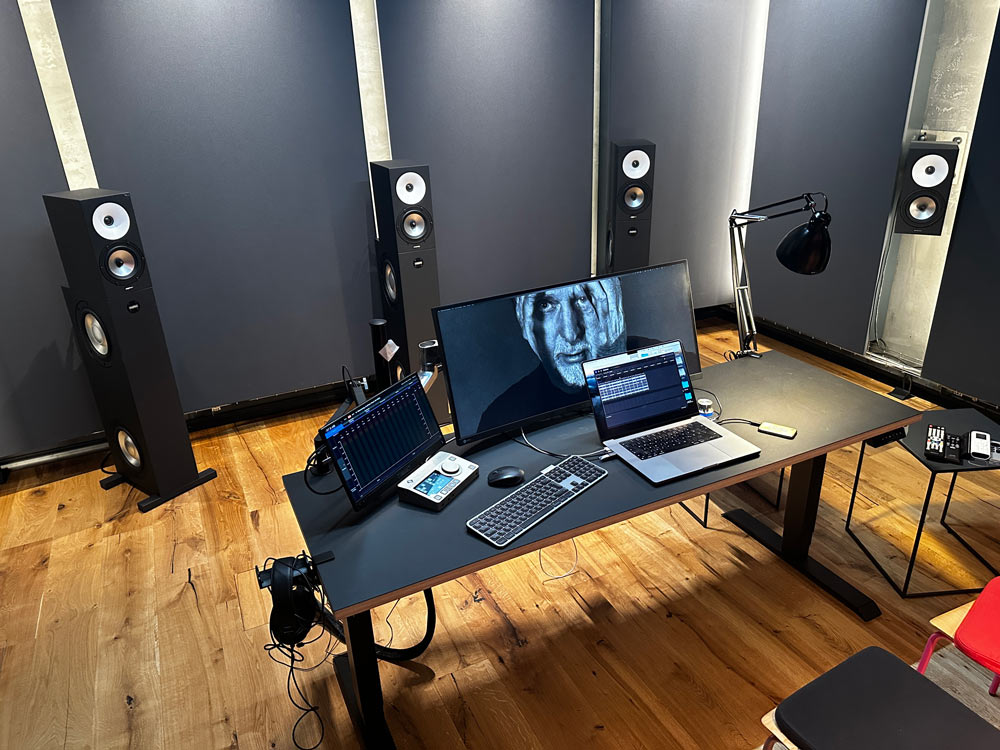 In general, Gabriel let Hans-Martin work for the time being. He gave him all the freedom he needed to do what he thought was appropriate. Then they listened to the first draft together and discussed it. Gabriel's comments never centred on the fact that all the recorded elements could be heard - nothing was sacred to him. His reasoning always centred on the fact that the story of the song had to be supported. Nothing was allowed to counteract or interfere with that. If, for example, a beautiful orchestral accompaniment in the intro to Playing For Time was distracting, it had to be turned down considerably. Apparently, Peter's philosophy was: I can only discard what I have recorded.
In general, Gabriel let Hans-Martin work for the time being. He gave him all the freedom he needed to do what he thought was appropriate. Then they listened to the first draft together and discussed it. Gabriel's comments never centred on the fact that all the recorded elements could be heard - nothing was sacred to him. His reasoning always centred on the fact that the story of the song had to be supported. Nothing was allowed to counteract or interfere with that. If, for example, a beautiful orchestral accompaniment in the intro to Playing For Time was distracting, it had to be turned down considerably. Apparently, Peter's philosophy was: I can only discard what I have recorded.
As a result, Hans-Martin then created 30 to 40 work steps from each song to the finished version in the work rhythm of mixing-counterlistening-mixing. Some of these variations were also due to the fact that an update of the project data came in from the studio with small changes or additions. Sometimes a few bars of a bridge were deleted, sometimes a few new sounds were recorded. Hans-Martin always had to go through his work status and adapt it accordingly.
We have now made further progress with our audio demonstration. The orchestral part of Playing For Time made it particularly clear what the special possibilities of Dolby Atmos are: Many details become more audible because the instruments can be distributed in the room and can therefore be perceived more precisely.
We are now at Road To Joy and Hans-Martin tells us that this was the biggest chunk on i/o. It has over 700 tracks, all of which he had to give their due attention, which meant almost two weeks of work. That's an enormous amount of time for a single song.
But Hans-Martin is also very pleased with the result. There's an enormous amount going on in the whole room. But it never becomes overloaded. Another strength of Atmos: there is plenty of space to spread things out.
 The splash at the end of the song was already there with Gabriel - but Hans-Martin re-recorded it at night (he shows us a short video on his notebook) at the mill lake in the Real World Studios - again to capture a fuller spatial sound with his 3D microphone. The result is more naturalistic - and at the same time surprisingly subtle.
The splash at the end of the song was already there with Gabriel - but Hans-Martin re-recorded it at night (he shows us a short video on his notebook) at the mill lake in the Real World Studios - again to capture a fuller spatial sound with his 3D microphone. The result is more naturalistic - and at the same time surprisingly subtle.
Incidentally, Hans-Martin has often run an instrument track loud in the Big Room or the Wood Room at Real World Studios and recorded it again with the existing room reverb. For him, this results in a more organic, fuller sound than when digital room simulations are used.
We have now arrived at Love Can Heal and Atmos can also show its full strengths here: The hypnotic web of sound is all around us. All its loops and tones come at us from the depths. Gabriel's "Give in to love" scream is at its most piercing here in the In-Side Mix. Originally, Hans-Martin wanted it to come from the ceiling above - but Gabriel said that the whole song would lead up to this sentence, that it couldn't come from the off, but had to be in the room.
The female voices in the chorus are more reduced in the final phase, especially the ornaments by Ríoghnach Connolly. That's because Gabriel didn't want to hear them so strongly here - it's different in the stereo mixes.
Our visit is already quite long. And it's really exciting. - Not only to hear the tracks in their Atmos versions, and in a technically excellent environment, but of course also to chat to Hans-Martin about all the contexts. But our window of opportunity is gradually closing.
At some point, however, we reach the last track on the album. Hans-Martin tells us that Live And Let Live was a little too undynamic for him. So, in consultation with Gabriel, he added a few vocals from the recording of the i/o concert in London (the most recent show available at the time) as amplification.
At the end, the piece runs out into a recording of "Summer Sounds" (as it says in the credits). This is, in particular, the striking twittering of birds. We ask how this idea came about. Well, more out of necessity, Hans-Martin admits. The main reason for this was that the Dark-Side Mix had to be provided as a stereo backup for a release on the Apple platform - and as both mixes have to run in parallel, they have to have the same playing time. However, the Dark-Side Mix fades out very gently and is therefore very long. In order to achieve the same running time, Hans-Martin added this nature recording. Gabriel was initially a little sceptical about this. However, as it represents the absolute conclusion of the album, he finally accepted it.
And now we've finished all the songs. We chat a little and reflect on our impressions. Hans-Martin's mixes are very lively, convey an authentic sound and little technical alteration (although Hans-Martin has done a lot of processing). They create an experience without simple-minded effects, they don't want to overwhelm or obfuscate. They are tangible and honest, swinging and grooving.
As a mixer, Hans-Martin saw himself as a service provider (even if it seems that he is not entirely comfortable with that term). He wasn't the producer, so he didn't help develop the direction a song should take, didn't decide what should be recorded, didn't have the final say on what should ultimately be heard. But mixing for Dolby Atmos requires special work. The possibilities are greater, the demands on the recording material are also greater, a special sensibility is required. There are also more opportunities to make mistakes or succumb to temptation. Hans-Martin is therefore pleased that he was able to exert more influence with i/o than a mixer generally can.
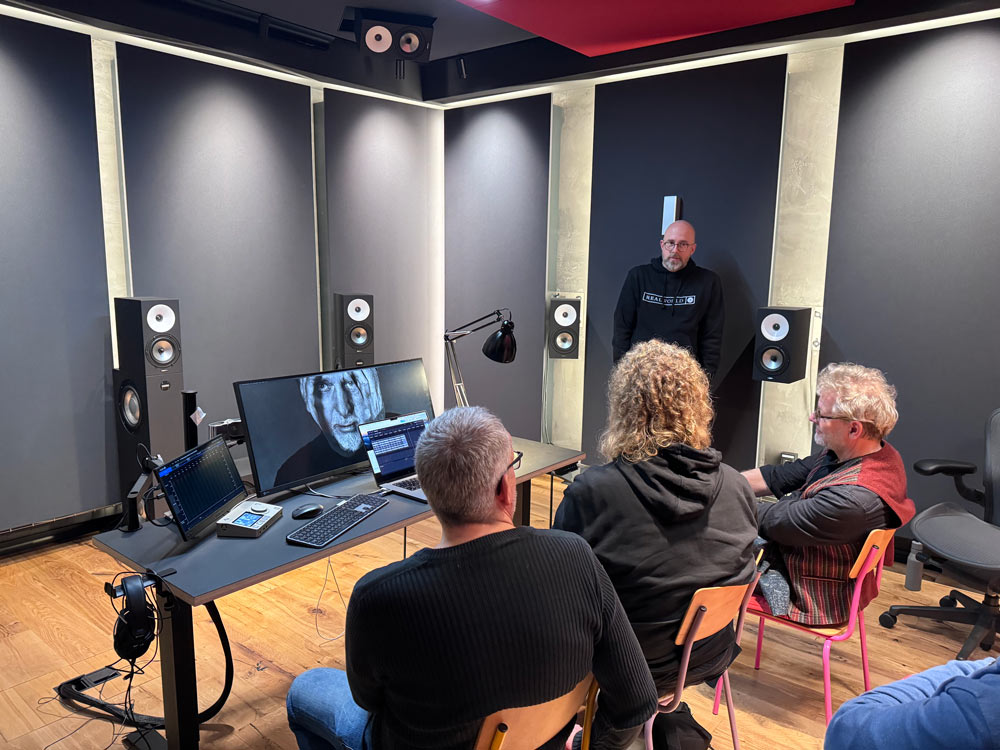 He also admits that he has songs on i/o that are closer to him than others. He has a particularly good relation to Four Kinds Of Horses, Road To Joy and Love Can Heal.
He also admits that he has songs on i/o that are closer to him than others. He has a particularly good relation to Four Kinds Of Horses, Road To Joy and Love Can Heal.
What really impressed him about Gabriel's approach was the way he focussed on a song. Unlike Prince (with whom he has also worked), for example, who was able to record an entire album's worth of songs in one weekend, but then the songs were finished for him and he completely discarded many of them when in doubt, Gabriel doesn't give up. He holds on to good ideas and tweaks a piece until it really works for him. Hans-Martin says that he would like to take something from this attitude for himself.
He was also very impressed by how much Gabriel endeavours to support his employees at Real World Studios. Especially the technicians. He tries to give them opportunities for development wherever possible. This seems to be important to him - and he gives his attention to everybody, no matter if it’s a producer or an intern.
We were given three hours for the album presentation. In the end, we overrun by 15 minutes and only then do we pack our things. Hans-Martin bids us a relaxed goodbye at the door. He seems pleased to have done this with us. It's still not nice weather outside. It has become dark. We stand together for a while and exchange impressions.
We were offered something. We were able to experience the album in a real Atmos setting - who has that at home? There were also clear differences to the experience with a 5.1 system or headphones.
We also had an uncomplicated encounter with a world-class music producer and mixer. And we were able to get an impression of how Gabriel works. It's not often that you get the chance to experience something so directly.
But in the end it doesn't help: we have to leave, dispersing in the directions we came from. But the evening echoes on.

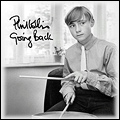

New Album featuring Motown Classics. Release date: September 13th, 2010 (Europe), September 28th (NA)
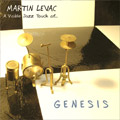

Brand new album by Martin Levac. Contains eleven Genesis-classics in Jazz style.